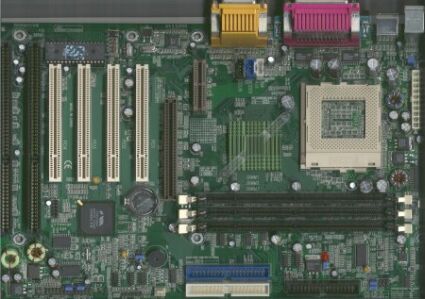12 Socket 370 Motherboards using VIA's Apollo Pro 133A
QDI Advance 10
Board Revision: 1.0
BIOS Version: 1.0 (March 11, 2000)
The QDI motherboard differs from all others by being green instead of standard brown. Even the chipset cooler is green. According to the meaning of green colour, it stands for hope. Let's see what's behind it!
The Chinese company did good work when labeling the on-board connectors. Two ISA and four PCI slots are waiting for your expansion cards as well as three DIMM sockets for up to 1.5 GBytes SDRAM. QDI also supports ECC and ships an excellent manual, which covers all topics of interest.
Interesting is QDI's Recovery Easy function. That's a little BIOS sub-program, which lets you make a copy of your boot partition to another partition. Of course you may abuse this funtion to switch between two, three or four active partitions. That's great for users who regularly use several operating systems and don't want to trust boot managers or don't want to install two operating systems onto the same partition.
In the BIOS there's also the Speed Easy setup which lets you chose all CPU setup parameters, including common FSB speeds between 66 and 150 MHz.
QDI included a header to make use of two more USB ports. And voilá, the required cable was inside the package! That's how things have to be, as USB ports can today be used by almost all kind of hardware. Starting with keyboards or mice, printers, scanners or digicams.
Get Tom's Hardware's best news and in-depth reviews, straight to your inbox.
In my opinion the Advance 10 has the best motherboard design of this round up. Just make sure that you get PCB version 3.0, as the capacitors have moved a bit away from the socket. QDI had to do this, as some coolers just could not be attached.
The performance you will get from the Advance 10 is quite good. Again, there may be faster boards, but this one comes with the useful Recovery Easy, a very good design, excellent manual, complete shipment including an ATX cover which may be needed in some cases and likely a good price as well. That's why I'm recommending this one.

Patrick Schmid was the editor-in-chief for Tom's Hardware from 2005 to 2006. He wrote numerous articles on a wide range of hardware topics, including storage, CPUs, and system builds.
